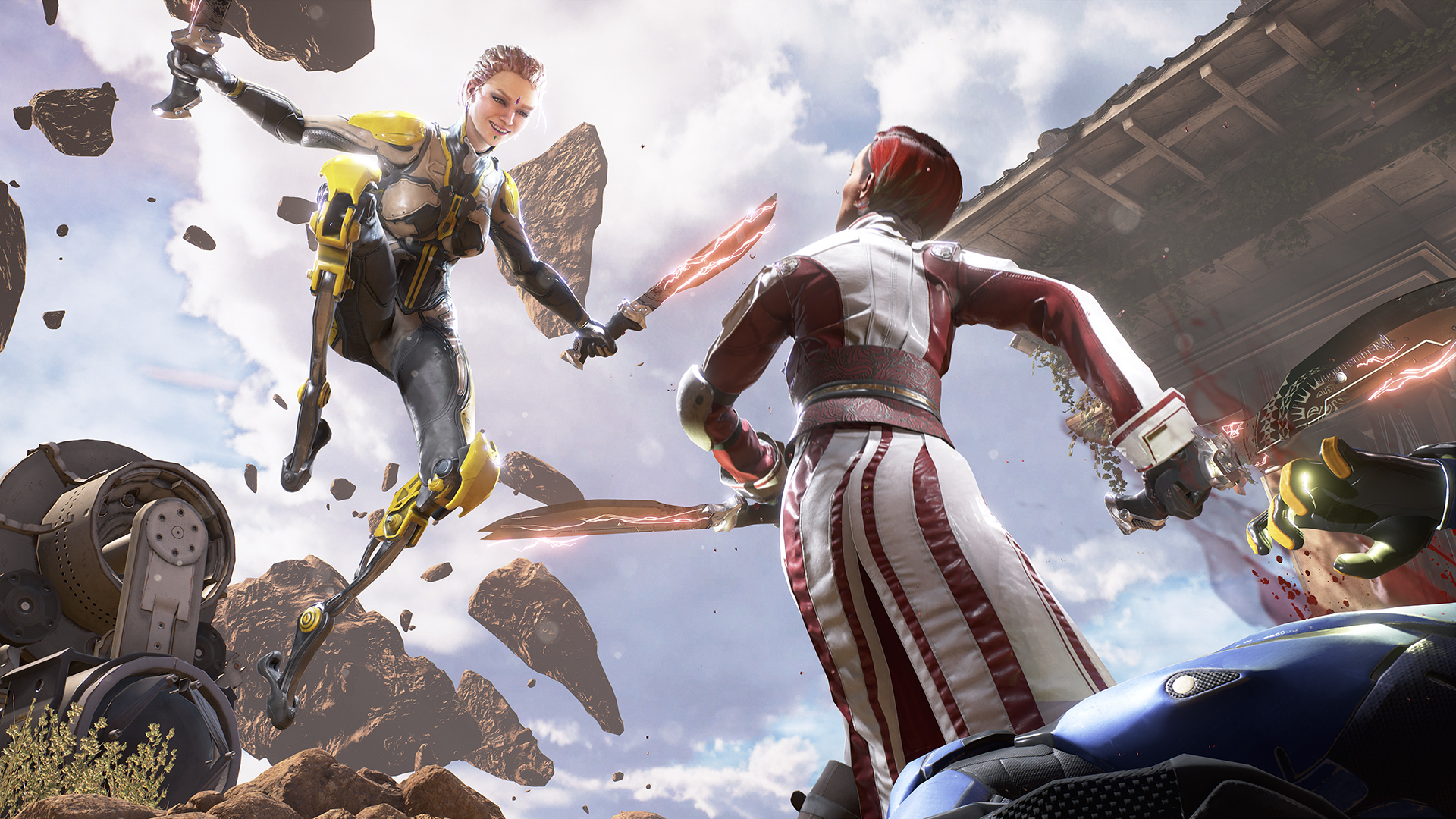Our Verdict
Nimble, graceful, and original, LawBreakers' movement sets it apart from other FPSes despite a few aesthetic weaknesses.
PC Gamer's got your back
What is it? A competitive FPS that offers skillful, unconventional styles of movement in many of its nine classes.
Expect to pay: $30 / £25
Developer: Boss Key Productions
Publisher: Nexon
Reviewed on: Intel Core i7-4770K, Geforce GTX 980 Ti, 16GB RAM
Multiplayer: 10 players
Link: Official site
Buy it: Steam, Humble Store
Read our affiliate policy.
LawBreakers succeeds as an FPS because it embraces and gives a middle finger to the last five years of FPS design. From a distance, Boss Key's first game looks like another five-on-five 'hero shooter' where each of the characters bring unique guns and unique movement, combat, and ultimate abilities (that you trigger off the Q key) into arena maps to contend for objectives. But beneath that basic structure are big, welcome divergences from Overwatch and similar games.
One example: LawBreakers has no true support characters. The closest thing to a healer, the Battle Medic, employs 'fire and forget' healing, delegating the work to drones that automatically fly to teammates when you hit E, leaving your hands free to lob grenades. I love the ease of this role, and the challenge of maintaining lines-of-sight with teammates as you're both flying: assigning a drone to an Assassin as they swing like Spider-Man into an enemy base, or saving a teammate who's about to die with a single key tap from across the map.
This is the only FPS I can think of that lets me shoot behind myself.
In this way LawBreakers pleasantly bypasses the concept of classes as battlefield jobs. There aren't turrets, teleporters, tanks per se, or other distractions. There aren't even conventional snipers, or guns with any kind of magnification, because LawBreakers doesn't want you losing sight of the importance of movement. Everyone is expected to fly, fight, and contribute damage.
In place of any ordinary class archetypes, LawBreakers builds variety through its distinct styles of movement, and it's here that hardcore FPS players will find delightful nuance. Take the Wraith, who slides along the ground to accelerate, jabbing the air with a knife to swim forward in low-grav. They can also triple jump and wall jump, a moveset that gives the Wraith a darting, alien locomotion that's enjoyable to master.
Each role has a fun micro-skill or two to learn, adding depth and steepening the learning curve in most cases. Gunslingers teleport in 15-foot bursts like Tracer from Overwatch, but the first shots from either of their dual pistols are buffed immediately after you blink. If you fly backwards as the Harrier, you shoot lasers from your boots that can fend off pursuers. This is the only FPS I can think of that lets me shoot behind myself, nevermind turns it into a way to physically propel yourself forward.
I found a couple of these movement styles uncomfortable, and you probably will too. I felt fragile and clumsy as the Assassin, who uses a grappling hook to swing into stabbing range. But Boss Key could've easily strapped the same jetpack to each character and called it a day. The wide range of motion not only gives LawBreakers a clear identity, but these movement styles make characters more identifiable at a distance, making it easier to decide how to engage. It's a huge asset to the game.
The forms of movement have good relationships with LawBreakers' guns—big, imaginative energy and explosive weapons that are the children of Unreal Tournament. As Harrier, I have to mark a target with a debuffing dart, then grit my teeth as I paint an enemy with my Iron Man-like laser beam. The simplicity of the Battle Medic's grenade launcher is great: left click throws grenades that detonate on impact, and right click pops out ones that bounce. I like the moment-to-moment geometry I'm asked to do to decide which grenade will be more effective.
I also appreciate that the power level of ultimate abilities, which charge up on a flat timer, isn't so high that you're constantly anticipating them or playing around them, like I often do in Overwatch. They're flashy stalemate-breakers, but carving out a triple kill with Harrier's chest beam, or Titan's Palpatine-grade hand lightning, feels earned.
What's my mode-tivation?
Less imaginative are LawBreakers' five modes, which don't differ much from one another. Uplink and Overcharge are both basically about bringing a single, flag-like object back to your base and defending it as you wait for it to fully charge, which scores a point. Turf War and Occupy are capture point modes, the latter one makes you chase a single point that changes positions like Headquarters in Call of Duty.
But the lack of novelty doesn't bother me because these modes succeed at stimulating urgency and creative movement, and prompting you to make clever timing plays with ultimate abilities. They make LawBreakers a more interesting game, one about solving physical problems while you're perpetually in motion rather than just fragging.
For example, to snatch the battery away from the enemy's base and run it back to mine, I have to figure out how to fly in at high speed—but not in a straight line, which will probably kill me—and still leave enough jetpack juice to make a getaway.
I'm impressed that the frequent transitions you make between pockets of low and normal gravity aren't disorienting.
Different roles excel on different maps and modes, giving the meta a nice texture. Dropping the Battle Medic's ultimate, a bubble that blocks projectiles in both directions and heals allies, on a capture point can seal the deal. In Blitzball—basically LawBreakers rugby—the robotic Juggernauts often come up clutch with their shield ability, putting up a literal wall to for fast-moving, would-be dunkers to slam their faces into.
Given all this focus on finesse and skill (LawBreakers goes as far as assigning you a letter grade after each match), I don't know why there isn't a separate competitive mode here, or why you can't specify which maps and modes you want to queue into. In the absence of a server browser you can create custom games, or jump into a practice area solo to work on movement skills. At least the netcode is rock solid, which is frankly necessary for a game that's this latency-intolerant. The set of graphics and other options are likewise good, erasing the fact that LawBreakers is a multiplatform game. I've had excellent, 120-plus fps on my GTX 980 Ti at 1440p, on high settings.
Less in LawBreakers' favor is how vulnerable it is to AFK players and leavers, similarly to five-on-five games like Rainbow Six Siege. There's a reporting tool, but no votekick function to aid with these situations. In my experience over the past week, LawBreakers backfills vacant slots fairly quickly, and despite some concerns about player population that have circulated over Reddit I haven't waited more than two minutes to queue into a match over the past week.
Above: The cosmetics, a combination of gun skins, gun stickers, profile portraits, 'boot prints,' and character skins, come in the same sort of buyable or earnable loot crates found in Overwatch and other games.
Catch phrases
Mechanically interesting as they are, LawBreakers' characters don't do enough to create emotional attachment. LawBreakers doesn't answer the question of who the Law and Breakers are. There needs to be more banter between characters, or stuff that expresses the spirit of these sci-fi gladiators.
LawBreakers could've benefitted from committing more to being silly or being serious. Rick and Morty's Justin Roiland voices the Blitzball in the mode of the same name, but he doesn't have enough lines to make this cameo more than a gag. The contextual barks that your own characters make during combat range from corny ("You're the LawBreaker, and I'm the neck-breaker!") to generic ("Your date with destiny is done!") to borrowed catch phrases ("Always be closing!"). I don't need poetry, but I'd settle for substance—I want to know slightly more about these jetpacking weirdos and why they're fighting.
It's not all on their levitating shoulders, though, because the maps also don't carry the thematic weight of the game. Way back in 2015, we heard that LawBreakers was set in a world where the moon exploded. But this cataclysmic event doesn't feel reflected much by the elegant but samey sci-fi facilities you float around in. Most of them look like they're part of the same neighborhood, cohesive but under-contrasted.
That's ultimately fine, because the maps' symmetrical layouts are so fun to traverse. I like lobbing grenades into the broken-open moon sculpture at the center of Promenade and watching them rattle around. I love the long leap of faith into the enemy's base you make from the center of Vertigo, which as a friend described to me yesterday, is LawBreakers' equivalent of Facing Worlds. I love the orbiting duels that play out around the towers in Trench and Reactor. And throughout, I'm impressed that the frequent transitions you make between pockets of low and normal gravity aren't disorienting, but exciting. Hitting low gravity almost always feels like an opportunity to slingshot yourself forward, or something that buys you more time to line up a shot. The resources you're given to manage lift and make aerial adjustments are fun to grapple with, but you have to manage them wisely. The whole set of mechanics form a well-designed midpoint between empowerment and helplessness.
Modest aesthetic sins aside, LawBreakers' low-grav ballet sticks with me. Overused jargon like "verticality" doesn't capture the moments of flow you feel as you, somehow, tag a teleporting, levitating enemy with back-to-back grenades in mid-air, or kick three different enemies in the face to block a Blitzball touchdown. It feels like rugby played on the moon: brutal, parabolic, jousting, and nimble.
In this mini-renaissance the genre is in the midst of, LawBreakers asserts itself as a complex, physical, and deep competitive shooter. It's an uncompromising game that doesn't make apologies for its high skill ceiling, but isn't so exclusionary that only those with pristine reflexes can enjoy it. There's a quiet gracefulness to managing the Battle Medic's hoverpack, knowing when to toggle the hover on and off to conserve fuel. It's a treat to play an FPS where some of the roles demand more left-hand coordination than they do mouse aim.
Nimble, graceful, and original, LawBreakers' movement sets it apart from other FPSes despite a few aesthetic weaknesses.

Evan's a hardcore FPS enthusiast who joined PC Gamer in 2008. After an era spent publishing reviews, news, and cover features, he now oversees editorial operations for PC Gamer worldwide, including setting policy, training, and editing stories written by the wider team. His most-played FPSes are CS:GO, Team Fortress 2, Team Fortress Classic, Rainbow Six Siege, and Arma 2. His first multiplayer FPS was Quake 2, played on serial LAN in his uncle's basement, the ideal conditions for instilling a lifelong fondness for fragging. Evan also leads production of the PC Gaming Show, the annual E3 showcase event dedicated to PC gaming.


